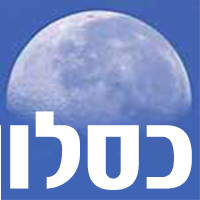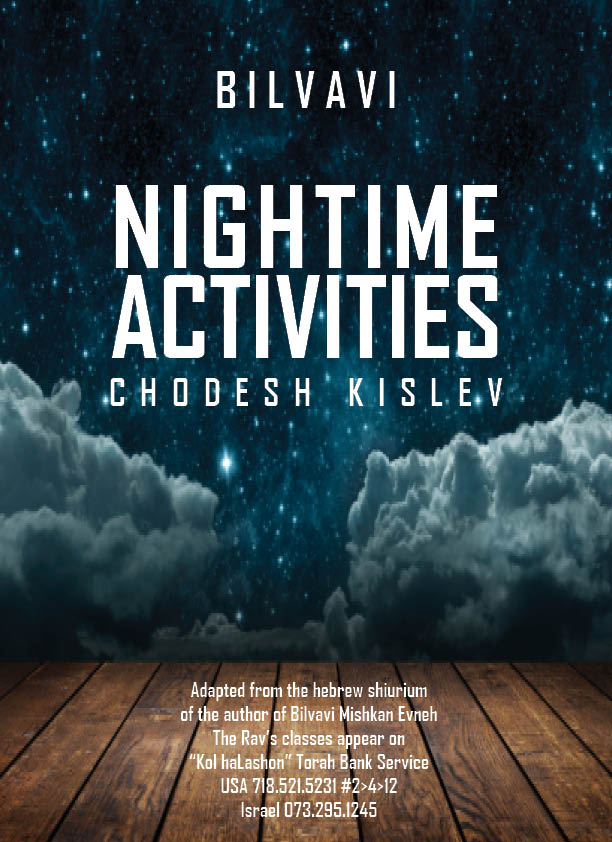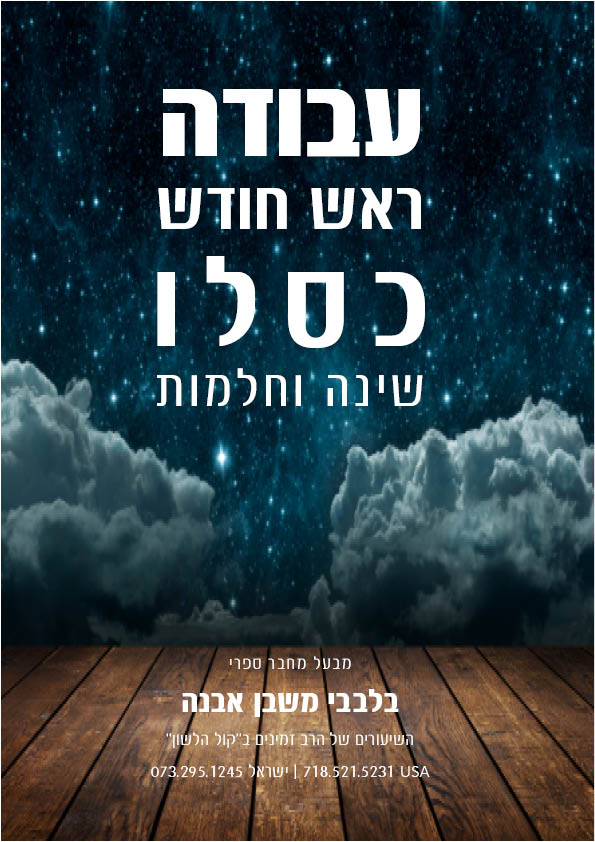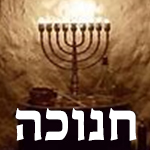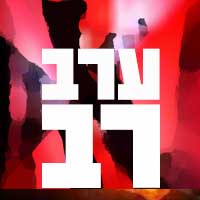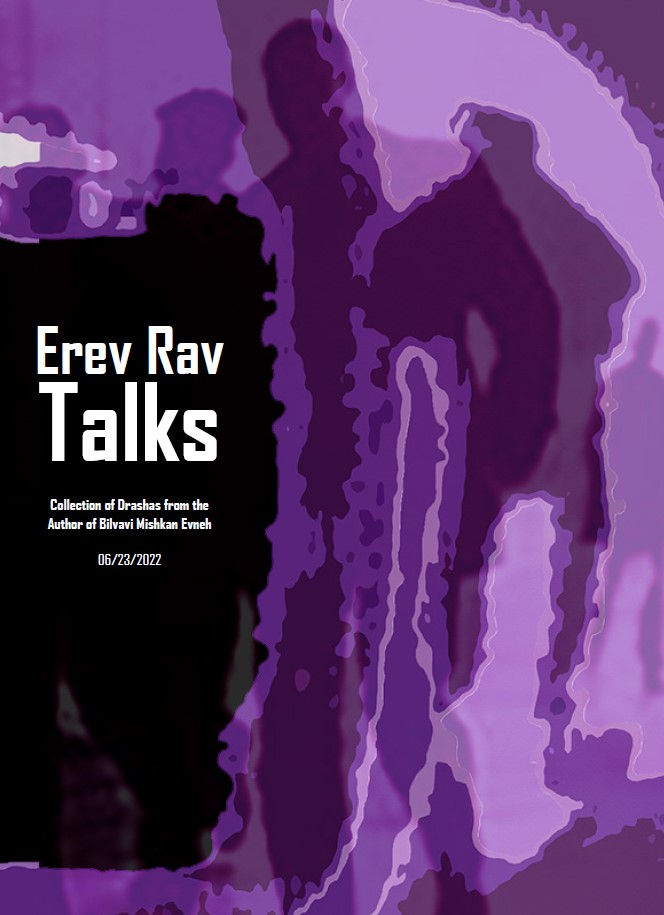- להאזנה שיחת השבוע 022 כי תשא קשר ישיר עם הקב-ה וקשר דרך אמצעי תשעז
022 Ki Tisa | Turning To Hashem Directly
- להאזנה שיחת השבוע 022 כי תשא קשר ישיר עם הקב-ה וקשר דרך אמצעי תשעז
Weekly Shmuess - 022 Ki Tisa | Turning To Hashem Directly
- 6082 reads
- Printer-friendly version
- שלח דף במייל
The Attitude That Led To The Eigel (The Golden Calf)
In Parshas Ki Sisa we learn about the sin with the eigel (the golden calf), during the pandemonium among the people that resulted from Moshe’s absence.
Chazal explain that at first, Hashem spoke directly to Klal Yisrael, without the means of a messenger, but they grew afraid of His voice because they thought they would die, and so they requested of Moshe that instead Hashem should speak to them only through Moshe. So at first, the Jewish people heard Hashem’s voice at Har Sinai, and afterwards they requested a change, that Hashem’s word should not come to them directly, but only through means of a medium - through Moshe.
As a result of this change, when their messenger Moshe was absent from them, they sought a replacement for Moshe, and that was what led them to form the image of the golden calf, to serve as a medium between Klal Yisrael and Hashem. Upon more subtle study of the events, it was really a medium that was fashioned in order to quell the members of the Erev Rav (the Mixed Multitude), who were demanding some kind of replacement for Moshe.
The change that took place once the people requested a “medium” to go between them and Hashem was not just a temporary change that took place at Har Sinai. The event of standing at Sinai was a root of history to come, and therefore whatever took place at Sinai had effects for the rest of history. The event of standing at Har Sinai was a root of Creation, so whatever took place then affected the entire fabric of Creation since then, as well as the Torah, which the entire Creation is linked with, for “Hashem looked into the Torah to create the world”. The change in which Klal Yisrael would no longer hear Hashem’s world directly, but only through means of a medium, would forever change the design of Creation.
Two Ways of Connecting To Hashem: Directly, and Through A Medium
To explain this matter at its root: there is the Creator, His creations, and the connecting point between them. Hashem, in His wisdom, allows for the created beings to have a connection with Him, in two possible ways. One way is in a “direct” manner, in which a person can “directly” connect to the Creator: when he stands before Him in prayer and converses with Him. A second way of how we can connect to the Creator is an indirect manner, by means of a medium, which can serve as a bridging point between the Jewish people and their Father in Heaven.
Standing at Har Sinai contained both of these ways of connection. There was a revelation of Hashem there, and this was a direct connection between created being and Creator. At Har Sinai, there was also the giving of the Torah. The Torah is intrinsically tied with Hashem (“Three ties are bound one with another – The Blessed One, the Torah, and Yisrael”) and one can therefore connect to Hashem via the means of the Torah.
When Hashem spoke to Klal Yisrael, this was a “direct” connection. We still retain this connection on some level in the form of prayer, and in doing His will, which “directly” connects us with Hashem. That was one aspect of standing at Har Sinai - the “direct” connection with Hashem. A second aspect of standing at Har Sinai was the revelation of the Torah, which serves as the medium between us and our Father in Heaven, which enables us to have d’veykus (attachment) to the Creator.
If not for the sin, we would have kept the “direct” connection to Hashem, with no medium in between, of hearing Hashem’s voice speaking to us, in addition to the connection to Hashem that we have via the means of the Torah.
But when the people requested that Hashem’s words be transmitted to them through a messenger, as opposed to hearing Hashem directly, the “direct” connection with Hashem became hidden and concealed. Ever since then, our main connection with Hashem must come via the “medium” of the Torah, which is the “soul” of the world, as well as in all souls of the Jewish people, by way of Moshe Rabbeinu who transmitted to us the Torah.
But to understand this better, these two forms of connection to Hashem (direct connection, and connection through a medium) were already rooted into Creation. The connection to Hashem via a medium existed through Torah, represented mainly by Moshe, as well as all wise sages who transmit the Torah to the Jewish people (as one of the sages in the Gemara said to his student, “Moshe, you have said it well”). But before the sin, the main connection we had with Hashem was direct.
Although we had also had Torah then before the sin, for the word of Hashem is ultimately “Torah”, the main aspect of our connection to Hashem was direct, and it was a Torah directly from Hashem. But after the sin, our main connection to Hashem is now through Torah, and the “direct” connection to Hashem remains in a hidden dimension, where it is concealed.
After the sin, when we received the second set of Luchos, our Torah learning is the main connection we have with Hashem, whereas our “direct” connection with Hashem, to have “d’veykus in the Creator”, is hidden. The Nefesh HaChaim explains at length that true attachment to Torah means to learn Torah in order to have d’veykus in the Creator.
A huge change happened to creation after the sin with the Golden Calf. Before the sin, we had direct communication with Hashem, and the “word of Hashem” was the “Torah” that spoke to us, in addition to the words we spoke to Hashem, which were prayer; Hashem’s word to us was called Torah, and our words with Hashem were called prayer. That was the state before the sin.
As a result of the sin, Hashem’s word to us is now hidden. Moshe could see Hashem’s word more clearly than all other prophets, and there is still ruach hakodesh and there is still the Heavenly “bas kol”, but the “word of Hashem” is no longer openly revealed. To Hashem, the Torah is His word, but from our human perspective, Torah to us is just Torah, and the “word of Hashem” contained in the Torah remains hidden from our view. For this reason, the Nefesh HaChaim wrote that d’veykus in Torah is to a means of d’veykus in Hashem.
So there is direct connection with Hashem, and there is connection to Hashem that is clothed in the form of a medium (Torah). The Torah currently conceals Hashem from us, Who is hidden in it.
However, the Ramchal and others explained that although the sin with the golden calf ruined the state of Creation and the level of the Jewish people was no longer the same as when they stood at Har Sinai, and the Torah that we have today is only on the level of the second Luchos, which we received on Yom Kippur – in spite of all this, the Ramchal says that we still retain some of the original level.
To prove this point, the Torah commands us to celebrate Shavuos as the time of the giving of the Torah, and if we had truly lost it, there would no longer be a requirement to remember the giving of the Torah. It must be, says the Ramchal, that the original light of standing at Har Sinai still exists, and it is just covered and hidden.
Two Kinds of Prayer
We can use prayer as an example, where we can see each of these forms of connection. When a person is praying, either he is praying to Hashem Himself and for no other reason, or he is praying on behalf of a sick person, or he is praying for his own requests and he seeks Hashem’s mercy.
The first kind of prayer (praying to Hashem Himself for no other reason) is the essence of Shemoneh Esrei, where one “stands before the King”, and it represents direct connection to Hashem. Therefore, Shemoneh Esrei represents the level of before the sin, where a person communicates “directly” with Hashem.
The second kind of prayer (requests) is like the level of Pesukei D’Zimrah, and the blessings of Shema, and Kerias Shema, which are not focused on “standing in front of the King”, and these prayers are like the level after the sin, where we need a medium to communicate with Hashem.
Thus, through Shemoneh Esrei, which the Men of Great Assembly established for us, we retain some level of our original connection with Hashem, which was direct.
How Much Should We To Turn Directly To Hashem?
One should recognize that he has two means of connection to Hashem – directly (from himself), and through a medium (these include the second Luchos, Moshe, the wise sages of every generation, the angels, and other means).
The depth of a Jew’s soul – and only a Jew’s soul - contains the power to turn directly to Hashem, with no need for a medium. But it is hidden deep in the soul. There are five names of the soul[1], which are like levels atop the other, and it is the inner essence of the soul which can turn directly to Hashem. The external layers of the soul turn to Hashem by way of a medium. But every Jew’s soul contains both of these powers.
There is a different soul root for every soul and there are also varying levels that a person may be on, which are factors that affect how much one is connection to Hashem through a medium (a holy kind of medium, of course, and not idol worship, chas v’shalom), versus how much one is connecting to Hashem directly.
Every soul needs a holy medium to connect to Hashem, but how much does the soul need to turn directly to Hashem, and how much does it need to make use of a medium? This depends on one’s soul root and his current level, which we mentioned above.
But if one only turns to Hashem directly, and never through means of a medium, he is denying the reality of the sin of the golden calf, as well as the second set of Luchos, and the concept of trusting the sages, and he is denying if the angels have any power (which they clearly do), and he is being delusional. Yet if a person goes in the opposite extreme and he never turns to Hashem directly, and he will only turn to tzaddikim for help, or to the angels, or to segulos, and other various means – then he has no connection to his own inner essence.
Therefore, the first stage of one’s avodah is to recognize that he needs “direct” connection to Hashem as well as connection to Hashem through a medium.
After that comes the deeper stage. After one has become purified internally, from learning Torah lishmah[2]and from serving Hashem with mesirus nefesh[3], and he has attained purity of heart, he has a greater chance of having a “direct” connection to Hashem. In contrast, the less that a person is genuinely serving Hashem, the more he will seek connection to Hashem through a medium.
The End of Days: A Time To Turn Directly To Hashem
But in the times we live in, when we are found in the depths of exile, in a time of suffering like this, any person has the power to “directly” turn to Hashem. The Sages said that the verse “In your suffering, you will find” refers to the suffering of the End of Days, when it is easier for us to find Hashem amidst our suffering. In the End of Days, there is much hester panim (concealment) and there is great suffering, both in the general sense and in the individual sense, and in a time of suffering, a person can turn directly to Hashem.
To illustrate, if a person is drowning in middle of the sea, he will not hope that a tzaddik pray for him. He will scream, from the depths of his heart, to Hashem, and directly to Hashem, to save him. This is like the situation of our generation right now. If one doesn’t feel how we are in a time of suffering, he is out of touch with reality. In the end of exile we are in, where we are facing the “50th Gate of Impurity” that surrounds us from all sides, we are drowning in middle of the sea, with no one but Hashem to save us.
In the times we live in, our physical lives are not in mortal danger (although we really have no idea what that will be like either), but our spiritual lives are. We are surrounded by tumah (spiritual defilement), the presence of evil, on all sides. This is what the Sages meant when they said that there will be much suffering in the End of Days. There is surely physical suffering today as well, but that is an offshoot of our dismal spiritual situation.
The evil today surrounds us from all sides that it can make us feel similar to Rabbi Eliezer ben Dordaya, who prayed to all of the universe to save him, until he realized, “The matter is not dependent on anything but me”[4], and then he groaned and cried until his soul left him, which meant that he reached the place in his soul which turns directly to Hashem. This is the revelation we can come to in the End of Days: to uncover our soul’s power of “direct” connection to Hashem.
There is a well-known teaching of our Sages that the greater the suffering, the more spiritual light it contains. This really means that the more dismal one’s situation is, the closer he is turning directly to Hashem. The external layer of the suffering is the deep suffering itself, but the inner layer of the suffering contains a great spiritual light: the ability to turn “directly” to Hashem.
We need to both turn to Hashem directly, as well as to turn to Him through various means, such as by seeking out the wise tzaddikim of each generation. But how much should we turn to Hashem directly, and how much should we seek various means to connect to Him? What should be the balance? The greater the suffering, the more we need to turn to Hashem directly.
The more a person feels the suffering that we are found in during the End of Days, instead of seeking to run away from all the suffering, one should uncover the depths of his heart. Then a person can slowly learn how to turn directly to Hashem, with less emphasis on requiring a medium to connect to Him.
This is the root of the matter of the “light of the future redemption.” The sages argued if the redemption will depend on teshuvah or not. According to one of the sages, if Klal Yisrael doesn’t do teshuvah, a king as harsh as Haman will rule and then everyone will be forced to do teshuvah and then be redeemed. In other words, the suffering will be so great that everyone will turn directly to Hashem from it. The suffering in our times can affect each person soul on a deep, core level, to the point that we can each be spurred on to turn to Hashem, directly.
Concerning the End of Days, the Sages taught that “the wisdom of scholars will rot.”[5] There are many ways to understand this matter, but for our purposes here, the deep meaning of this is that it will be such a time of suffering that people will stop turning to the sages and tzaddikim for help, and instead they will realize that the only answer is to turn directly to Hashem.
When a person reaches this point, he will hear, in the depths of his soul, the “word of Hashem” that is the Torah. Just as by Har Sinai the people heard the word of Hashem, when the soul turns directly to Hashem, it hears the “word of Hashem” in the Torah: “For from Zion comes forth Torah, and the word of Hashem from Jerusalem.” The more a person is turning directly to Hashem, the more Hashem will reciprocate in return, and reveal to the person a Torah that is His word.
The way of a true life, as we have been explaining here, is that a person turns to Hashem both “directly” as well as through the means of a “medium”. One can directly connect to Hashem by talking to Him privately, and one can spend hour or two hours a day conversing with Hashem about anything that bothers him[6]. As is well-known, the Chofetz Chaim would talk to Hashem for an hour or two hours a day, and converse with Him about anything that was troubling him, turning to Him directly. Along with this, a person needs to work his way upwards through the levels of serving Him, as a means to connect to Him.
But as these days continue, and we are further and further into the End of Days, where the suffering increases, and we become further from the time when we stood at Har Sinai where we heard the word of Hashem, as we draw closer to the end, we are actually becoming closer to the perspective of standing at Har Sinai, of hearing the word of Hashem.
Whereas in previous times our souls required a balance of direct connection with Hashem along using various mediums to connect to Him, in the current times we live in, the End of Days, we are drawing closer to the “word of Hashem” of Har Sinai, and therefore there is more of an opportunity for us to place more emphasis on a “direct” connection with Hashem, with less emphasis on connecting to Him through a “medium”.
In Summary and In Conclusion
These are subtle, refined matters. One needs to talk to Hashem, and this is like the level of Torah we had at Har Sinai in which we had a direct connection with Hashem. We can turn to Him through prayer, in third-person (as implied in the word “Baruch”, “Blessed” is Hashem) and then directly, in first-person (“Attah”, “You, Hashem”) – and in the times we live in, there should be more of a relationship with Hashem of “Attah”, “You” – directly.
The more that we merit turning to Hashem directly, it will be stemming from the depths of a pure heart. If we do not merit reaching this point of turning to Hashem directly, then we will be forced to turn to Him anyhow, from the great suffering of our times, which will leave a person with no choice other than to turn to directly to Hashem.
May Hashem give us the strength to build in ourselves the full spectrum of our avodah, and to use all of the holy means that we need in order to connect to Him, but along with this, may we merit to reach the depth of life, of turning directly to Hashem, and may it be revealed speedily in our times the complete reality of the One who created everything, and then all of the creations together will simply and clearly turn to Hashem, Himself.
[1] nefesh, ruach, neshamah, chayah and yechidah
[2] for non-ulterior motives
[3] “self-sacrifice”; great dedication
[4] Avodah Zarah 17a
[5] Sotah 49a
[6] The Rav, in many derashos, often emphasizes this idea of spending an hour a day or more talking to Hashem; the source for this is in sefer Derech Eitz Chaim of the Ramchal
NOTE: Final english versions are only found in the Rav's printed seforim »


